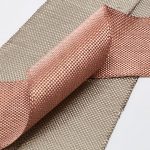Expand Your Development Team Series, Part 2 – Consider How We Can Help With Your Product Design
In Part One, we discussed product development considerations with polymer selection, part geometry, and molding conditions.
In today’s article our focus is on adding functionality to your product, part processing and finishing considerations:
Functional – Structural – Performance Platings
The most common functional metal platings are Copper and Nickel due to their relatively low cost and availability. As an example:

PC-ABS and PSU with Satin Nickel Finish
- Copper – typically serves as the backbone of conductive traces, antenna and RFI / EMI shielding applications. A typical part requiring RFI / EMI shielding first gets a layer of plated copper – about 12-20 microns thick. To provide anti-abrasion and anti-tarnish protection, a thinner top layer of nickel usually finishes the part
- Nickel – because of its versatility and economy, this metal is a frequent choice for designers. Wear and impact resistance, low level RFI / EMI shielding and corrosion protection are the prime attributes. It can be applied in both electrolytic and electroless methods
A myriad of attributes are attainable with SAT Plating’s proprietary Surface Activation® processing and the broader choice of polymer types it enables.
When used in combination with SAT’s SelectPlate® techniques, our customers can use the best plastics to achieve optimal price and performance for their parts and components. Among the many Functional – Structural – Performance features we can provide are:
• Conductivity • Corrosion Resistance • Abrasion Resistance
• Charging Circuits • Salt Spray Survivability • Wear / Impact Resistance
• Antennas • Chemical Resistance • Permeation Barrier
• Microwave Guides • UV Protection • Superior Adhesion
• RFI / EMI Shielding • Anti-microbial
Appearance Plating Finishes
Chromes – Bright Nickel Chrome | Black Chrome | Smoke Chrome
To achieve a high-gloss finish typical in automotive or appliance parts, these finishes have a total thickness of about 25 microns.
Nickels – Bright Nickel | Satin Nickel | Black Nickel
These can be applied in thicknesses from 1 micron to over 150 microns, but typically in the 10-15 micron range. Among other possibilities, nickels are often used to give a stainless steel appearance to a part.
Copper – Natural Copper | Bright Copper
99.9% pure copper can be plated from 1 micron upward. As with solid copper parts, these platings will age and patina. If a bright finish is to be maintained, a thin clear polymer top coating needs to be applied to inhibit tarnishing.
Silver– Natural Silver | Bright Silver
This metal, like copper, tarnishes rapidly – to maintain a bright finish, a thin clear polymer top coating is applied. Generally, there is less demand for aesthetic silver.
Gold
Gold has many characteristics that make it an appealing option for aerospace, medical, and appearance products, amongst others. From superior conductivity to bio-compatibility, gold is a logical choice for the right application.
Plating Thicknesses
Many of our customers come to us with their plating specifications already defined. Others have yet to establish plating types and thicknesses for their parts.
For example, engineers unfamiliar with RFI / EMI shielding often over-specify plating thicknesses in excess of what is actually needed. SAT Plating is an experienced resource and can assist in suggesting optimal plating thicknesses and combinations, using numerous military and industrial specifications publicly available (serving as empirical guidelines). In all cases, however, we highly recommend that each customer perform their own independent testing to confirm the efficacy of the plating in their specific application.
Selective Plating vs. Total Plating
When needed, SAT Plating has many proprietary SelectPlate® techniques for achieving selective plating to create:
- Conductive Traces
- Antennas
- Inductive Coils
- and more
Many electronic enclosures only need metal plating on the inside and not the outside for RFI / EMI shielding. It should be understood, however, that plating an entire part, inside and out, is often less expensive than partial or selective plating, even though more surface area is metalized.
For more information on how SAT can collaborate with your R&D Teams, please call us at 248.273.0037
© SAT Plating 2019






